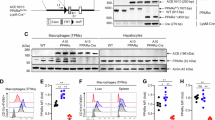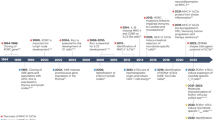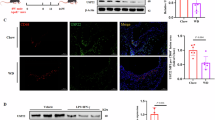Abstract
It is appreciated that phagocytosis of apoptotic cells (AC) is an immunological relevant process that shapes the pro- versus anti-inflammatory macrophage phenotype. It was our intention to study the respiratory burst, a prototype marker of macrophage activation, under the impact of AC. Following incubation of RAW264.7 macrophages with AC, we noticed attenuated production of reactive oxygen species (ROS) in response to PMA treatment, and observed a correlation between attenuated ROS formation and suppression of protein kinase Cα (PKCα) activation. EMSA analysis demonstrated an immediate activation of peroxisome proliferator-activated receptor-γ (PPARγ) following supplementation of AC to macrophages. In macrophages carrying a dominant-negative PPARγ mutant, recognition of AC no longer suppressed PKCα activation, and the initial phase of ROS formation was largely restored. Interference with actin polymerization and transwell experiments suggest that recognition of AC by macrophages suffices to attenuate the early phase of ROS formation that is attributed to PPARγ activation.
Similar content being viewed by others
Log in or create a free account to read this content
Gain free access to this article, as well as selected content from this journal and more on nature.com
or
Abbreviations
- AC:
-
apoptotic cells
- ROS:
-
reactive oxygen species
- PPARγ:
-
peroxisome proliferator-activated receptor-γ
- d/n:
-
dominant negative
- PKCα:
-
protein kinase Cα
References
Savill J and Fadok V (2000) Corpse clearance defines the meaning of cell death. Nature 407: 784–788
Freire-de-Lima CG, Nascimento DO, Soares MB, Bozza PT, Castro-Faria-Neto HC, de Mello FG, DosReis GA and Lopes MF (2000) Uptake of apoptotic cells drives the growth of a pathogenic trypanosome in macrophages. Nature 403: 199–203
Voll RE, Herrmann M, Roth EA, Stach C, Kalden JR and Girkontaite I (1997) Immunosuppressive effects of apoptotic cells. Nature 390: 350–351
Lambeth JD (2004) NOX enzymes and the biology of reactive oxygen. Nat. Rev. Immunol. 4: 181–189
Inanami O, Johnson JL, McAdara JK, Benna JE, Faust LR, Newburger PE and Babior BM (1998) Activation of the leukocyte NADPH oxidase by phorbol ester requires the phosphorylation of p47PHOX on serine 303 or 304. J. Biol. Chem. 273: 9539–9543
Bokoch GM and Diebold BA (2002) Current molecular models for NADPH oxidase regulation by Rac GTPase. Blood 100: 2692–2696
Larsen EC, DiGennaro JA, Saito N, Mehta S, Loegering DJ, Mazurkiewicz JE and Lennartz MR (2000) Differential requirement for classic and novel PKC isoforms in respiratory burst and phagocytosis in RAW 264.7 cells. J. Immunol. 165: 2809–2817
Li Q, Subbulakshmi V, Fields AP, Murray NR and Cathcart MK (1999) Protein kinase calpha regulates human monocyte O-2 production and low density lipoprotein lipid oxidation. J. Biol. Chem. 274: 3764–3771
von Knethen A, Tautenhahn A, Link H, Lindemann D and Brune B (2005) Activation-induced depletion of protein kinase C{alpha} provokes desensitization of monocytes/macrophages in sepsis. J. Immunol. 174: 4960–4965
von Knethen A and Brune B (2003) PPARgamma – an important regulator of monocyte/macrophage function. Arch. Immunol. Ther. Exp. (Warsz) 51: 219–226
Zhang X and Young HA (2002) PPAR and immune system – what do we know? Int. Immunopharmacol. 2: 1029–1044
Daynes RA and Jones DC (2002) Emerging roles of PPARs in inflammation and immunity. Nat. Rev. Immunol. 2: 748–759
Chung SW, Kang BY, Kim SH, Pak YK, Cho D, Trinchieri G and Kim TS (2000) Oxidized low density lipoprotein inhibits interleukin-12 production in lipopolysaccharide-activated mouse macrophages via direct interactions between peroxisome proliferator-activated receptor-gamma and nuclear factor-kappa B. J. Biol. Chem. 275: 32681–32687
Holloway AF, Rao S and Shannon MF (2002) Regulation of cytokine gene transcription in the immune system. Mol. Immunol. 38: 567–580
Cvetanovic M and Ucker DS (2004) Innate immune discrimination of apoptotic cells: repression of proinflammatory macrophage transcription is coupled directly to specific recognition. J. Immunol. 172: 880–889
Cocco RE and Ucker DS (2001) Distinct modes of macrophage recognition for apoptotic and necrotic cells are not specified exclusively by phosphatidylserine exposure. Mol. Biol. Cell 12: 919–930
Savill J, Dransfield I, Gregory C and Haslett C (2002) A blast from the past: clearance of apoptotic cells regulates immune responses. Nat. Rev. Immunol. 2: 965–975
Fadok VA, Bratton DL, Konowal A, Freed PW, Westcott JY and Henson PM (1998) Macrophages that have ingested apoptotic cells in vitro inhibit proinflammatory cytokine production through autocrine/paracrine mechanisms involving TGF-beta, PGE2, and PAF. J. Clin. Invest. 101: 890–898
Maasch C, Wagner S, Lindschau C, Alexander G, Buchner K, Gollasch M, Luft FC and Haller H (2000) Protein kinase calpha targeting is regulated by temporal and spatial changes in intracellular free calcium concentration [Ca(2+)](i). FASEB J. 14: 1653–1663
Serinkan BF, Gambelli F, Potapovich AI, Babu H, Giuseppe MD, Ortiz LA, Fabisiak JP and Kagan VE (2005) Apoptotic cells quench reactive oxygen and nitrogen species and modulate TNF-alpha/TGF-beta1 balance in activated macrophages: involvement of phosphatidylserine-dependent and -independent pathways. Cell Death Differ. 8: 1141–1144
Feng J, Han J, Pearce SFA, Silverstein RL, Gotto Jr AM, Hajjar DP and Nicholson AC (2000) Induction of CD36 expression by oxidized LDL and IL-4 by a common signaling pathway dependent on protein kinase C and PPAR-{gamma}. J. Lipid Res. 41: 688–696
Kagan VE, Gleiss B, Tyurina YY, Tyurin VA, Elenstrom-Magnusson C, Liu SX, Serinkan FB, Arroyo A, Chandra J, Orrenius S and Fadeel B (2002) A role for oxidative stress in apoptosis: oxidation and externalization of phosphatidylserine is required for macrophage clearance of cells undergoing Fas-mediated apoptosis. J. Immunol. 169: 487–499
Lauber K, Bohn E, Krober SM, Xiao YJ, Blumenthal SG, Lindemann RK, Marini P, Wiedig C, Zobywalski A, Baksh S, Xu Y, Autenrieth IB, Schulze-Osthoff K, Belka C, Stuhler G and Wesselborg S (2003) Apoptotic cells induce migration of phagocytes via caspase-3-mediated release of a lipid attraction signal. Cell 113: 717–730
Shiraki T, Kamiya N, Shiki S, Kodama TS, Kakizuka A and Jingami H (2005) Alpha,beta-unsaturated ketone is a core moiety of natural ligands for covalent binding to peroxisome proliferator-activated receptor gamma. J. Biol. Chem. 280: 14145–14153
McIntyre TM, Pontsler AV, Silva AR, St Hilaire A, Xu Y, Hinshaw JC, Zimmerman GA, Hama K, Aoki J, Arai H and Prestwich GD (2003) Identification of an intracellular receptor for lysophosphatidic acid (LPA): LPA is a transcellular PPARgamma agonist. Proc. Natl. Acad. Sci. USA 100: 131–136
Martin-Nizard F, Furman C, Delerive P, Kandoussi A, Fruchart JC, Staels B and Duriez P (2002) Peroxisome proliferator-activated receptor activators inhibit oxidized low-density lipoprotein-induced endothelin-1 secretion in endothelial cells. J. Cardiovasc. Pharmacol. 40: 822–831
Wakino S, Kintscher U, Liu Z, Kim S, Yin F, Ohba M, Kuroki T, Schonthal AH, Hsueh WA and Law RE (2001) Peroxisome proliferator-activated receptor gamma ligands inhibit mitogenic induction of p21Cip1 by modulating the protein kinase cdelta pathway in vascular smooth muscle cells. J. Biol. Chem. 276: 47650–47657
Patel H, Truant R, Rachubinski RA and Capone JP (2005) Activity and subcellular compartmentalization of peroxisome proliferator-activated receptor alpha are altered by the centrosome-associated protein CAP350. J. Cell Sci. 118: 175–186
Von Knethen A and Brune B (2002) Activation of peroxisome proliferator-activated receptor gamma by nitric oxide in monocytes/macrophages down-regulates p47phox and attenuates the respiratory burst. J. Immunol. 169: 2619–2626
Ricote M, Li AC, Willson TM, Kelly CJ and Glass CK (1998) The peroxisome proliferator-activated receptor-gamma is a negative regulator of macrophage activation. Nature 391: 79–82
Cernuda-Morollon E, Rodriguez-Pascual F, Klatt P, Lamas S and Perez-Sala D (2002) PPAR agonists amplify iNOS expression while inhibiting NF-{kappa}B: implications for mesangial cell. J. Am. Soc. Nephrol. 13: 2223–2231
Von Knethen A and Brune B (2001) Delayed activation of PPARgamma by LPS and IFN-gamma attenuates the oxidative burst in macrophages. FASEB J. 15: 535–544
Gurnell M, Wentworth JM, Agostini M, Adams M, Collingwood TN, Provenzano C, Browne PO, Rajanayagam O, Burris TP, Schwabe JW, Lazar MA and Chatterjee VK (2000) A dominant-negative peroxisome proliferator-activated receptor gamma (PPARgamma) mutant is a constitutive repressor and inhibits PPARgamma-mediated adipogenesis. J. Biol. Chem. 275: 5754–5759
Lindemann D, Bock M, Schweizer M and Rethwilm A (1997) Efficient pseudotyping of murine leukemia virus particles with chimeric human foamy virus envelope proteins. J. Virol. 71: 4815–4820
Pietschmann T, Heinkelein M, Heldmann M, Zentgraf H, Rethwilm A and Lindemann D (1999) Foamy virus capsids require the cognate envelope protein for particle export. J. Virol. 73: 2613–2621
Soneoka Y, Cannon PM, Ramsdale EE, Griffiths JC, Romano G, Kingsman SM and Kingsman AJ (1995) A transient three-plasmid expression system for the production of high titer retroviral vectors. Nucl. Acids Res. 23: 628–633
Tautenhahn A, Brune B and von Knethen A (2003) Activation-induced PPARgamma expression sensitizes primary human T cells toward apoptosis. J. Leukoc. Biol. 73: 665–672
Schulman IG, Shao G and Heyman RA (1998) Transactivation by retinoid X receptor-peroxisome proliferator-activated receptor gamma (PPARgamma) heterodimers: intermolecular synergy requires only the PPARgamma hormone-dependent activation function. Mol. Cell. Biol. 18: 3483–3494
Acknowledgements
The work was supported by grants from Deutsche Forschungsgemeinschaft (BR999). We thank Sandra Christmann and Nadja Wallner for excellent technical assistance.
Author information
Authors and Affiliations
Corresponding author
Additional information
Edited by B Zhivotovsky
Rights and permissions
About this article
Cite this article
Johann, A., von Knethen, A., Lindemann, D. et al. Recognition of apoptotic cells by macrophages activates the peroxisome proliferator-activated receptor-γ and attenuates the oxidative burst. Cell Death Differ 13, 1533–1540 (2006). https://doi.org/10.1038/sj.cdd.4401832
Received:
Revised:
Accepted:
Published:
Issue date:
DOI: https://doi.org/10.1038/sj.cdd.4401832
Keywords
This article is cited by
-
SILAC-based quantitative proteomics to investigate the eicosanoid associated inflammatory response in activated macrophages
Journal of Inflammation (2022)
-
Rab17 mediates differential antigen sorting following efferocytosis and phagocytosis
Cell Death & Disease (2016)
-
Innate apoptotic immunity: the calming touch of death
Cell Death & Differentiation (2008)
-
The signaling mechanism of ROS in tumor progression
Cancer and Metastasis Reviews (2007)



